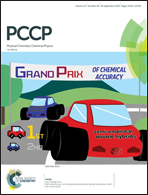Improved charge carrier dynamics in polymer/perovskite nanocrystal based hybrid ternary solar cells†
Abstract
Here, brand new ternary hybrid solar cells comprising perovskite nanocrystals (NCs) with a complementary absorption profile of the organic host matrix are reported. In particular, NH2CH![[double bond, length as m-dash]](https://www.rsc.org/images/entities/char_e001.gif) NH2PbI3 (FAPbI3) perovskite NCs are implemented in bulk heterojunction organic solar cells based on the pDPP5T-2 electron donating polymer and a [6,6]-phenyl-C61-butyric acid methyl ester (PC61BM) acceptor at various loading amounts and the fabricated hybrid photovoltaics are thoroughly studied by employing different optoelectrical characterization methods. Current–voltage measurements and photoinduced charge carrier extraction by linear increasing voltage (photo-CELIV) reveal improved charge generation and charge transport properties upon incorporation of perovskite NCs into the photo-active layer of the hybrid solar cell. The power conversion efficiency (PCE) of the hybrid solar cell comprising 5% perovskite NCs is 10% enhanced compared to the organic reference, mainly due to the enlarged light harvesting and increased short circuit current density (Jsc). However, results suggest that introducing a higher amount of perovskite content induces bimolecular and trap-assisted recombination in the ternary devices. We perform a comprehensive transient absorption study of the charge transfer/transport mechanisms by employing femto-second pump–probe transient absorption spectroscopy (fs-TAS). fs-TAS measurements demonstrate a slower charge carrier recombination rate due to the introduction of perovskite NCs into the photoactive layer. Results reveal that DPP injects electrons from the singlet excited state into the perovskite NCs, which causes the desired cascading charge carrier transfer. In ternary blends, a small amount of FAPbI3 NCs provides an additional pathway in favor of the charge-separated state via the NCs, which, despite accelerating the depopulation of DPP's singlet excited state slightly slows down the charge-separation process between DPP and PC61BM. Interestingly, the loss processes are slowed down; an effect that is more important and, hence, explains the improved solar cell efficiency.
NH2PbI3 (FAPbI3) perovskite NCs are implemented in bulk heterojunction organic solar cells based on the pDPP5T-2 electron donating polymer and a [6,6]-phenyl-C61-butyric acid methyl ester (PC61BM) acceptor at various loading amounts and the fabricated hybrid photovoltaics are thoroughly studied by employing different optoelectrical characterization methods. Current–voltage measurements and photoinduced charge carrier extraction by linear increasing voltage (photo-CELIV) reveal improved charge generation and charge transport properties upon incorporation of perovskite NCs into the photo-active layer of the hybrid solar cell. The power conversion efficiency (PCE) of the hybrid solar cell comprising 5% perovskite NCs is 10% enhanced compared to the organic reference, mainly due to the enlarged light harvesting and increased short circuit current density (Jsc). However, results suggest that introducing a higher amount of perovskite content induces bimolecular and trap-assisted recombination in the ternary devices. We perform a comprehensive transient absorption study of the charge transfer/transport mechanisms by employing femto-second pump–probe transient absorption spectroscopy (fs-TAS). fs-TAS measurements demonstrate a slower charge carrier recombination rate due to the introduction of perovskite NCs into the photoactive layer. Results reveal that DPP injects electrons from the singlet excited state into the perovskite NCs, which causes the desired cascading charge carrier transfer. In ternary blends, a small amount of FAPbI3 NCs provides an additional pathway in favor of the charge-separated state via the NCs, which, despite accelerating the depopulation of DPP's singlet excited state slightly slows down the charge-separation process between DPP and PC61BM. Interestingly, the loss processes are slowed down; an effect that is more important and, hence, explains the improved solar cell efficiency.



 Please wait while we load your content...
Please wait while we load your content...